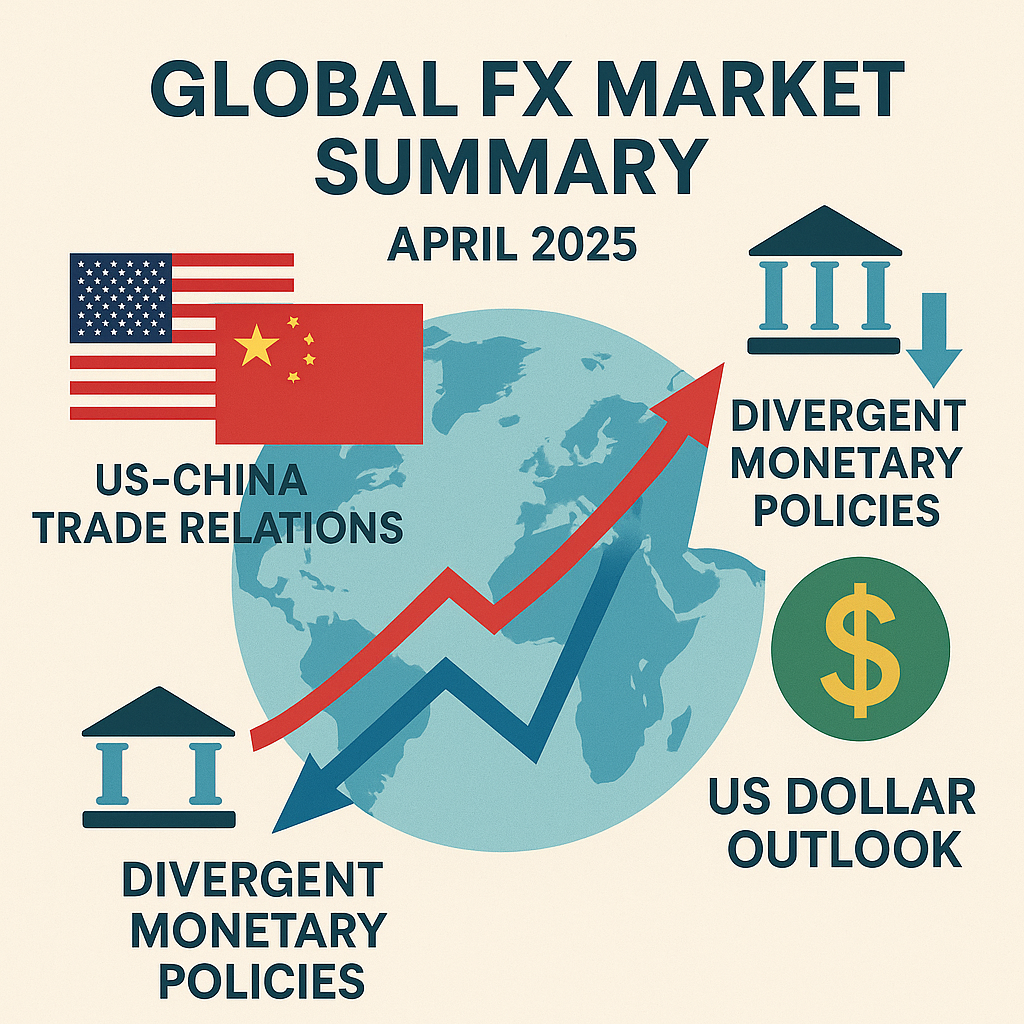Introduction
The global foreign exchange markets in April 2025 have been shaped by a complex interplay of trade tensions, contrasting monetary policies from major central banks, and fluctuating sentiment around the US Dollar. Investors are navigating an increasingly volatile environment as the economic policies of the world’s two largest economies continue to diverge and central banks worldwide adjust their monetary strategies in response to persistent inflationary pressures and economic uncertainty. This article provides an in-depth look at the major forces influencing the forex market, focusing on the US-China trade dynamics, policy shifts by leading central banks, and the evolving role of the US Dollar in global finance.
The Impact Of US-China Trade Relations On The FX Market
Trade relations between the United States and China have always been a critical driver of forex market volatility. In April 2025, new rounds of tariff implementations and countermeasures have heightened tensions, leading to increased uncertainty among investors. The Biden administration introduced additional tariffs on select Chinese goods, citing concerns over technology transfers and national security. In response, China retaliated with its own set of tariffs targeting American agricultural products and technology sectors.
This escalation has had a profound effect on currency markets. The Chinese yuan weakened sharply against the US Dollar, breaching the symbolic 7.2 level, while Asian currencies broadly depreciated due to fears of reduced trade volumes and economic slowdown. Investors seeking safe-haven assets turned to the US Dollar initially, pushing the DXY Dollar Index to new highs. However, this strength proved to be volatile as questions emerged about the long-term implications for US growth and inflation.
For forex traders and investors, understanding the nuances of these trade disputes is essential. Short-term gains in the US Dollar may be offset by longer-term structural risks to the American economy, particularly if trade disruptions persist and dampen consumer sentiment and business investment. Similarly, emerging markets heavily dependent on exports to China have seen their currencies come under pressure, amplifying the need for diversified investment strategies.
Divergent Monetary Policies: A Tale Of Two Strategies
Another dominant theme shaping forex markets in April 2025 is the clear divergence in monetary policy strategies among major central banks. While the Federal Reserve in the United States has maintained a restrictive stance, holding interest rates at a 20-year high to combat sticky inflation, other central banks have started signaling a pivot towards monetary easing.
In particular, the European Central Bank (ECB) surprised markets by hinting at possible rate cuts later in the year, citing a faster-than-expected decline in inflation and concerns about stagnant economic growth in the eurozone. Similarly, the Bank of Japan (BoJ) continued its ultra-loose monetary policy despite rising inflation, prioritizing economic recovery over price stability targets.
This divergence has significant implications for forex investors. A hawkish Fed relative to a dovish ECB or BoJ naturally supports the US Dollar against the euro and the yen. Consequently, EUR/USD and USD/JPY have both experienced notable shifts, with the euro struggling to maintain parity and the yen testing critical psychological support levels. Currency strategists expect these trends to persist into the second half of the year unless macroeconomic data drastically alters central bank priorities.
Investors must remain vigilant, closely monitoring inflation reports, labor market data, and GDP growth figures across major economies to anticipate policy adjustments and recalibrate their forex positions accordingly.
US Dollar Volatility: Strength And Structural Challenges
The US Dollar’s performance in April 2025 reflects a classic case of strength amid global uncertainty, but also exposes underlying vulnerabilities that could undermine its long-term outlook. The Dollar remains the primary safe-haven currency during periods of heightened risk aversion, and the combination of US-China trade tensions and monetary policy divergence initially boosted Dollar demand.
However, cracks have begun to appear. Slowing US economic indicators, particularly weaker retail sales and manufacturing output, have raised concerns about a potential recession later this year. Inflation remains elevated, but core inflation is showing signs of cooling, complicating the Federal Reserve’s policy calculus. Furthermore, growing fiscal deficits and questions about the long-term sustainability of US debt have triggered warnings from rating agencies, subtly eroding confidence in the Dollar.
From a global investor perspective, while the Dollar remains a key part of diversified portfolios, the need to hedge against Dollar volatility is becoming increasingly apparent. Alternative assets such as gold, select emerging market currencies, and even digital currencies are gaining traction as potential counterweights in investment strategies.
The Role Of Emerging Markets In The Current FX Landscape
Emerging market (EM) currencies have experienced heightened volatility amid the current macroeconomic backdrop. Rising US interest rates typically pressure EM currencies by making Dollar-denominated debt more expensive to service and attracting capital flows away from riskier assets. In April 2025, this dynamic has played out with notable intensity.
Latin American currencies like the Brazilian real and Mexican peso have depreciated, while Asian currencies linked closely to Chinese economic performance, such as the South Korean won and the Malaysian ringgit, have also weakened. Some exceptions exist, however. The Indian rupee has shown relative resilience, supported by strong economic fundamentals and proactive central bank interventions.
Investors in the EM space must be highly selective, focusing on countries with manageable external balances, credible monetary policies, and domestic demand-driven growth. Hedging currency exposures or utilizing FX derivatives remains critical in managing risks during such uncertain periods.
Central Banks As A Market Force Beyond Interest Rates
While interest rate policy remains the most visible tool at central banks’ disposal, April 2025 highlights that other forms of intervention are becoming increasingly relevant. Several central banks, including the People’s Bank of China (PBoC) and the Swiss National Bank (SNB), have engaged in direct foreign exchange market operations to stabilize their currencies or manage capital flows.
In particular, China’s approach to managing the yuan’s depreciation involved a mix of verbal intervention, tighter liquidity conditions, and administrative measures aimed at discouraging speculative attacks. The effectiveness of these policies has been mixed, underscoring the limitations of central bank influence in a world where market forces are increasingly interconnected and sophisticated.
For investors, understanding the broader toolbox central banks employ—beyond just rate decisions—is vital for anticipating market movements and protecting portfolios from unexpected shocks.
Outlook For The Remainder Of 2025: Scenarios And Strategies
Looking ahead, several scenarios could unfold that would have profound impacts on the FX market:
A resolution or de-escalation of US-China trade tensions would likely reduce demand for the US Dollar as a safe haven and support a rebound in Asian and emerging market currencies. However, if negotiations fail or further tariffs are imposed, Dollar strength could intensify alongside broader market volatility.
Central bank policies may continue to diverge. If the Federal Reserve maintains its hawkish stance while the ECB and BoJ ease, the Dollar is likely to outperform the euro and yen. However, any indication that the Fed might cut rates in response to economic weakness could trigger a sharp Dollar sell-off.
Structural issues such as US fiscal deficits and the global move towards de-dollarization, driven by countries seeking alternatives to the Dollar for trade and reserves, could gather pace, gradually undermining the Dollar’s dominance.
Investors should prepare for a dynamic environment by adopting flexible, data-driven strategies. Maintaining diversified currency exposures, utilizing hedging instruments, and staying informed about geopolitical developments will be key to success in the months ahead.
Conclusion
April 2025 has presented forex investors with a landscape marked by significant challenges and opportunities. US-China trade relations continue to inject volatility into markets, divergent central bank policies are reshaping currency dynamics, and the US Dollar remains both a source of strength and a potential vulnerability. Navigating this complex environment requires a deep understanding of macroeconomic trends, careful portfolio management, and an unwavering commitment to staying informed. While risks are ever-present, so too are opportunities for those willing to adapt and innovate in response to a rapidly changing world.



